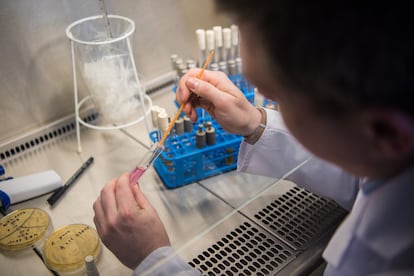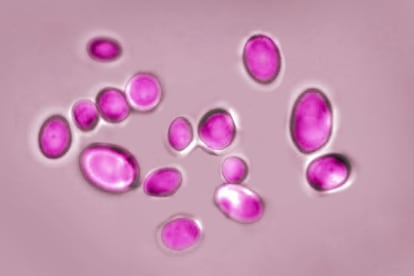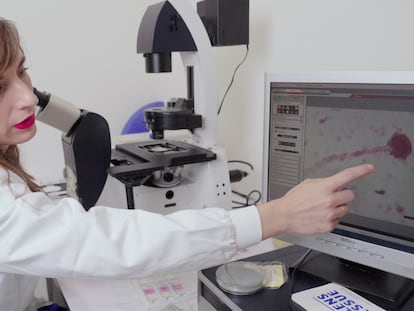How the deadly fungus ‘Candida auris’ spreads of out of control in a hospital
A new study highlights the difficulty of controlling an outbreak even after prevention protocols, such as patient isolation, have been put into place

The first cases of Candida auris in a 1,200-bed teaching hospital in northern Italy — the largest in the region of Liguria — were detected in 2019. Since then, the outbreak of this fungus, which is potentially deadly for humans, is still not contained. More than 500 cases have been recorded so far, with new ones reported every month. The fungus — classified by the World Health Organization as a “critical fungal pathogen” last year — is resisting all treatments used against it. That’s according to a new study in the journal Eurosurveillance, which demonstrates how difficult it is to stop the spread of the organism in a hospital.
The fungus is relatively new to humans. A cousin of Candida albicans (which causes a very common sexually transmitted disease), it was discovered in Japan in 2009 and has since appeared in other parts of the world in cases that appear to have no link to the first outbreak. It can be transmitted to humans through the skin and through contact with contaminated surfaces, and its ideal breeding ground is hospitals, where all reported cases have been detected up to now. Once inside a hospital, the fungus is able to prey on weak, often immunosuppressed patients. It colonizes the pathways through which patients receive drugs and enters their bloodstream, causing invasive candidiasis, the most serious infection sparked by Candida auris. The mortality rate for the infection can exceed 50%.
After a handful of cases were detected in the Liguria hospital in 2019, the fungus multiplied: by the last quarter of 2020, the center had more than 50. Since then, the figure has remained more or less stable, with some ups and downs, despite the fact that the hospital has carried out all measures to stop the spread: prevention, disinfection and patient isolation. “The most interesting thing about the article is that it shows how [Candida albicans] develops resistance due to prolonged exposure to echinocandins [main drugs for this fungus] and emphasizes the importance of early detection and the need to improve optimization programs on the use of antimicrobials,” says Ana Alastruey-Izquierdo, a researcher at the Carlos III Health Institute (ISCIII) in Spain.
The case in Italy reminds Alastruey-Izquierdo of the 2016 Candida albicans outbreak in Hospital de la Fe in Valencia, Spain. This was the largest hospital outbreak of the fungus in the world: more than a thousand cases were reported, and there continue to be infections, although the number has been contained to around a dozen a year, Javier Pemán, the head of the hospital’s mycology unit, told EL PAÍS.
Since then, there has been no official record, as it is not mandatory to report these infections. At the end of 2022, Eurosurveillance published its own count (with data from 2013 to 2021) that raised the number of infections in Europe to 1,813. The vast majority (1,377) were registered in Spain, and almost all of them were detected in the hospital in Valencia. But experts believe these numbers are greatly underestimated.
“It is very important to detect the fungus as soon as the first case appears, start contact precautions (isolate the patient if possible), carry out a contact study to rule out the presence of more cases and use the appropriate disinfectants to prevent it from establishing itself in the hospital. I believe that the delay in detecting the first cases has made Spain an endemic region for Candida auris. There have been cases in various centers since 2016, while in other parts of Spain, there have been cases, but no outbreaks,” says Alastruey-Izquierdo.

Episodes such as the Italian outbreak highlight the enormous difficulty of tackling the fungus when it is no longer isolated cases. “It seems that Candida auris has a special ability to colonize the hospital environment, and once it is established in a center it is difficult to eliminate it. And it shows that we still do not have the tools to handle this situation, despite the fact that much more is known about this species now than in 2016,” adds Alastruey-Izquierdo.
However, Rafael Ortí Lucas, president of the Spanish Society of Preventive Medicine, Public Health and Health Management, says that in hospitals such as the Valencia Clinic, where he works, they have managed to stop quickly the spread by following the protocols of rapid detection, disinfection and isolation.
But there are added difficulties when it comes to containing the fungus: it does not respond to some traditional hospital disinfectants (such as those in hydroalcoholic gels), meaning bleach has to be used. The fungus is “very tough,” says Julio García, the spokesperson for the Spanish Society of Infectious Diseases and Clinical Microbiology (SEIMC). In his opinion, the Covid crisis helped the fungus multiply in hospitals due to the large number of patients in intensive care, and the fact that the medical world was focused on the coronavirus.
Rise in fungal infections
García is “concerned” about the spread of this fungus and others that may come in the future. The most widely accepted hypothesis so far is that Candida auris has proliferated thanks to climate change. It is based on the same premise as the apocalyptic TV show The Last of Us (although the consequences have so far not been as dramatic). Fungi are organisms that have a very difficult time growing inside the human body due to its high temperature. But global warming may be promoting adaptations and making it easier for them to grow at 37ºC (98.6ºF), the average normal body temperature. This means that “more and more fungi have the capacity to infect,” according to Alastruey-Izquierdo.
The researcher points out that not all of these fungi have Candida auris’ ability to resist antifungals and disinfectants, nor its capacity to spread. “Although the threat is there, I don’t think we should be alarmed today,” she says. Alastruey-Izquierdo points out that the main problem is that fungi, unlike bacteria and viruses, have eukaryotic cells, like humans, and therefore it is “much more difficult” to find treatments that are not toxic to us as well. “Right now, we only have four families of antifungals capable of treating serious infections in humans,” she adds.
Alastruey-Izquierdo is calling for more funding to develop new treatments. Of the total budget that goes towards studying infectious diseases, less than 1.5% of that is dedicated to research on global fungal infections. “Throughout the world, there is also a significant lack of awareness [about the problem] and a lack of availability and access to the right diagnoses and treatment, probably in part as a result of the lack of funding,” she explains.
Sign up for our weekly newsletter to get more English-language news coverage from EL PAÍS USA Edition
Tu suscripción se está usando en otro dispositivo
¿Quieres añadir otro usuario a tu suscripción?
Si continúas leyendo en este dispositivo, no se podrá leer en el otro.
FlechaTu suscripción se está usando en otro dispositivo y solo puedes acceder a EL PAÍS desde un dispositivo a la vez.
Si quieres compartir tu cuenta, cambia tu suscripción a la modalidad Premium, así podrás añadir otro usuario. Cada uno accederá con su propia cuenta de email, lo que os permitirá personalizar vuestra experiencia en EL PAÍS.
¿Tienes una suscripción de empresa? Accede aquí para contratar más cuentas.
En el caso de no saber quién está usando tu cuenta, te recomendamos cambiar tu contraseña aquí.
Si decides continuar compartiendo tu cuenta, este mensaje se mostrará en tu dispositivo y en el de la otra persona que está usando tu cuenta de forma indefinida, afectando a tu experiencia de lectura. Puedes consultar aquí los términos y condiciones de la suscripción digital.
More information
Últimas noticias
More than 40 Democratic lawmakers urge Trump in a letter to stop his ‘attempts to undermine democracy in Brazil’
The journal ‘Science’ criticizes Trump’s anti-renewable energy policy: ‘The US is failing to benefit from its own innovations’
Cubans hope for a miracle as dengue and chikungunya spread
The long shadow of the father figure in the films of Rob Reiner
Most viewed
- Christian Louboutin: ‘Young people don’t want to be like their parents. And if their parents wear sneakers, they’re going to look for something else’
- Cartels in Mexico take a leap forward with narco-drones: ‘It is criminal groups that are leading the innovation race’
- ‘El Limones’ and the growing union disguise of Mexican organized crime
- Liset Menéndez de la Prida, neuroscientist: ‘It’s not normal to constantly seek pleasure; it’s important to be bored, to be calm’
- The low-cost creative revolution: How technology is making art accessible to everyone











































